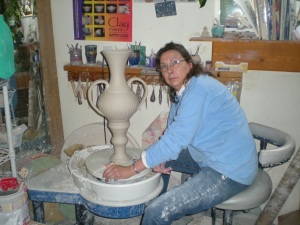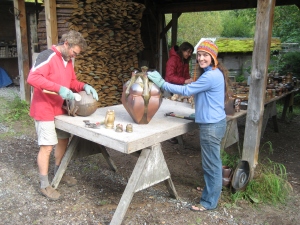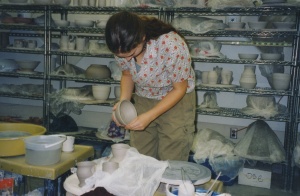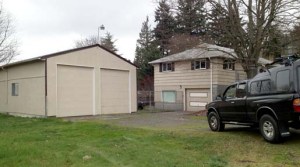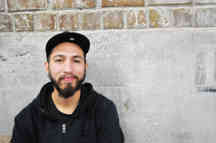I wanted to close out 2013 in style, and what better way than to feature my dear friend: the lovely and talented Deborah Schwartzkopf!
 Deborah and I have shared many memories together. As fellow undergraduate students at the University of Alaska, Anchorage, we simultaneously fell in love with clay and chose to follow a career path in ceramics. Since then, we both went off to post-bacc programs, then graduate school, then we were lucky enough to overlap for a year at the Archie Bray Foundation! I always cherish the time I get to spend with Deb and feel fortunate to have such a caring friend. Plus…when we do catch up, I get to hear about her crazy adventures as she travels the world sharing her work with others.
Deborah and I have shared many memories together. As fellow undergraduate students at the University of Alaska, Anchorage, we simultaneously fell in love with clay and chose to follow a career path in ceramics. Since then, we both went off to post-bacc programs, then graduate school, then we were lucky enough to overlap for a year at the Archie Bray Foundation! I always cherish the time I get to spend with Deb and feel fortunate to have such a caring friend. Plus…when we do catch up, I get to hear about her crazy adventures as she travels the world sharing her work with others.
 Her work is, and has always been exceptional. Her forms showcase strength and innovation and her surfaces are both dramatic and poetic. Her pots speak volumes…about history, design, utility, presentation, ergonomics…the list goes on. Whether you know Deb or not, this interview will give you a glimpse of the person behind the pottery. The dialogue is thorough and thoughtful, honest and informative…enjoy!
Her work is, and has always been exceptional. Her forms showcase strength and innovation and her surfaces are both dramatic and poetic. Her pots speak volumes…about history, design, utility, presentation, ergonomics…the list goes on. Whether you know Deb or not, this interview will give you a glimpse of the person behind the pottery. The dialogue is thorough and thoughtful, honest and informative…enjoy!
How did you first get involved in ceramics? Can you briefly describe your background and education?
I have broad interests outside of ceramics- gardening, Banjo, handicrafts of all kinds, spending time outdoors cycling or hiking, foraging wild plants and mushrooms, baking bread and cooking, and now house projects galore. My broad interests outside the arts initially made it a challenge to choose a direction in school or otherwise. In undergrad, I remember wanting a different major every week, from botany to philosophy from ceramics to literature. Nearly everything interested me. In high school I took a ceramics class at a community college in Seattle through a running start program. I enjoyed it among many other course subjects. When I moved to Alaska a few years later I took it again as an undergraduate at the University of Alaska: Anchorage. At this point in my life I was looking to redefine myself. I really started to dedicate to being a potter when I found an amazing community in my classmates, instructors, and mentors. I had a fantastic undergrad experience. I was encouraged to visit local potters by instructors and I did. Jen Allen (blog extraordinaire) helped me get my first job working with Anchorage, with local potter Kris Bliss. I owe much to both of them for caring about me and for teaching me everything from loading kilns to packing and shipping. I later worked for another local potter, Peter Brondz. Assisting and learning from these two potters taught me to take my academic education and apply it.
Once I figured out that I wanted to work in clay, I did it as much as possible through school, mentorships, jobs, and workshops. My education at UAA was an amazingly strong starting place. I worked mainly with Steve Godfrey and Robert Banker. I built up my throwing skills in Steve’s class. He was a demanding, supportive instructor. Steve helped me build me first kiln on his own time (which involved cutting bricks in Alaska’s winter). Our classroom was his studio, so we also got the benefit of watching him work on his own forms and deadlines. Robert Banker taught me how to hand build pots- to translate ideas from drawings and templates into clay. He would read to us during class. He built tables for the studio, showed us how to take images, and gently guided. These two gave me a foundation! When visiting artists came to Alaska, I tried my best to get in the workshop… Jeff Oestreick, Malcom Davis, Linda Christianson, Mary Barringer, Frank Boyden, Ayumi Horie, Mikey Walsh, Josh DeWeese, Doug Jeck… From all of these voices and ways of seeing and making I found a path to follow as my own.
How do you feel that your formal education (undergraduate-graduate school) prepared you for your career in ceramics?
At UAA I really learned techniques for making pottery. My undergrad experience it tied to working for local potters. They were simultaneous. The techniques I learned come from both places. In other words I learned how to make. As a special student at SDSU I learned how to work with ceramic materials and develop my surface. In grad school, at Penn State, there the focus was on why I made pottery and communicating my ideas through my work.
I took to heart the critical feedback I received and practiced in school. I work well in a structured environment. The specific assignments, clear deadlines, and critiques of the school environment kept me working harder than I would have on my own, gave me diverse feedback and a growing, long term network of friendships that still impacts my life.
Working in school settings allowed me to experiment with out penalty. Trying out new ideas often involves waste… Forms that do not work out because they have missed the mark or are full of cracks. A round of doing test tiles often amounts to just one or two that really sing. At school, it was expected that ideas would be worked through, that failure would happen. One of the biggest blessings working in school gave me was a buffer from having to earn a living from my work. It allowed me to play and discover. Growth and understanding was the focus. I spent time figuring out and speaking about why I made what I made, and then refined these ideas and forms. I made a lot of awkward work and filled trash barrels with unwanted glaze test tiles.
 In every school experience my instructors were role models who I still look up to. Each of these people deeply influenced me and came into my journey at seemingly just the right time. They were all so generous with their energy and thoughts. Each of them was a sounding board for me. They attentively pointed me toward a next step, suggested ideas to consider, introduced artist I ought to know about, pointed me toward examples in the field, proposed galleries I should inquire with, and after graduating have been encouraging. Maybe it seems obvious, but a big thing I learned throughout school is that specific questions, got more specific answers. And you have to look and ask for what you need.
In every school experience my instructors were role models who I still look up to. Each of these people deeply influenced me and came into my journey at seemingly just the right time. They were all so generous with their energy and thoughts. Each of them was a sounding board for me. They attentively pointed me toward a next step, suggested ideas to consider, introduced artist I ought to know about, pointed me toward examples in the field, proposed galleries I should inquire with, and after graduating have been encouraging. Maybe it seems obvious, but a big thing I learned throughout school is that specific questions, got more specific answers. And you have to look and ask for what you need.
You attended a post-bac program at San Diego State University with Richard Burkett. How did that year help your career path?
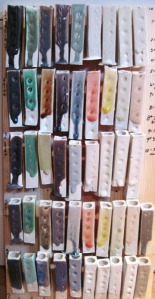 When I graduated from UAA, I felt that the area I needed most growth in was surface or glaze chemistry. I had not moved on from using shop glazes. I chose to work with Richard Burkett who is a glaze/ ceramic materials wizard. I tested glazes and materials all semester in his class and received great feedback from he and Joanne Hayakawa, who was also teaching at SDSU. I focused on my hand building also. I got better at making complicated templates, and practiced the new palette I was building on these new forms. Looking back, this was the first place I explained my work to people who knew little about my work or me. Nothing was assumed. Every choice was in question. The practice of verbalizing my work to people who did not know me, helped prepare me for grad school. I also made more friends there and expanded my thoughts about what people made in clay and got to know another clay community.
When I graduated from UAA, I felt that the area I needed most growth in was surface or glaze chemistry. I had not moved on from using shop glazes. I chose to work with Richard Burkett who is a glaze/ ceramic materials wizard. I tested glazes and materials all semester in his class and received great feedback from he and Joanne Hayakawa, who was also teaching at SDSU. I focused on my hand building also. I got better at making complicated templates, and practiced the new palette I was building on these new forms. Looking back, this was the first place I explained my work to people who knew little about my work or me. Nothing was assumed. Every choice was in question. The practice of verbalizing my work to people who did not know me, helped prepare me for grad school. I also made more friends there and expanded my thoughts about what people made in clay and got to know another clay community.
You’ve attended numerous residency programs and presented at countless conferences/workshops throughout your career. Could you describe some of the most influential or career changing experiences you’ve had?
Wally Bivins asked me to teach my first workshop at Pottery Northwest in Seattle. It was so amazing to have someone I did not really know be so supportive and give me a chance. For one of the first times I felt like someone thought I had something to contribute. I was so nervous and pleased. I did my best, but was just learning to how to explain and make at the same time. Over the years teaching workshops has elucidated my decisions- what choices I make and why I make them. Teaching has helped me see my work from the outside and to bring ephemeral thoughts into words. This has led to a fluency that helps me work through new forms or ideas more thoroughly.
I think moving back to Seattle and purchasing a home with studio space is one of the most career changing experiences I have had. Setting up my own studio has been so totally different than any residency. I have become more thankful than ever for all time I have spent at each studio over the years. With every location I learned an important key to getting this all going on my own. Yet, when it actually came setting up my own studio, it was still totally overwhelming and a huge amount of work. The changes are just starting in my career. We can now offer lessons, seminars, studio space, or mentorship. Having a space that truly works for what I need is a huge gift. It is an overwhelming step. One I have wanted for some time. I am curious and excited to see what comes of it.
Can you talk a bit about your journey including the struggles/sacrifices you made to get where you are today?
One of the biggest sacrifices I made was not being near my family. This separation helped me grow in ways that I wanted. However, I did miss important holidays. Also, when my grandmother was very ill with cancer I could not visit as much. I did not have the same connection to her in her passing that the rest of my family did. Now that I live close I can feel how the consistency of in being home regularly for lunch outings and simple walks feels very different than yearly visits for major holidays. I keep in touch with many people who I have crossed paths with. They are one of the greatest gifts of traveling and working in a multitude of communities. On the flip side it is difficult even now having my close friends all over rather than in my neighborhood or city or even state where we may share daily experience or confide in each other face to face. I feel that I have learned much from moving around, being able to be flexible to the situation, materials, or facilities. This is a gift of experience. But I think it is equally important to be able to stay and to ground myself in my local community, to give back and to keep lasting relationships.
You recently purchased a home in Seattle and have been transforming the garage into your studio. How did you arrive at the decision to settle and build a studio? What were your must-haves when building your studio and choosing a location?
The 1947 rambler I bought has a 1200 sq. ft. daylight basement which is acting as my studio and there is also a large separate workshop (800 sq ft. with 12 foot ceilings) that is acting as, my partner, George’s studio and where we will eventually also rent studio space and have space for our assistants to have their own work area. We also just built a kiln shed (roughly 400 sq.ft. footprint) for a gas kiln and three electrics… We are excited to grow into this space.
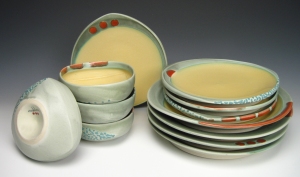 It is hard to have a long list of must haves and a small budget. Generally the more you need the more expensive it can be. My ideal studio for myself was patterned after the set-up a mentor of mine, Peter Brondz, has. His facility in Alaska demonstrated how a studio potter made use of space for making, storing materials/ bricks/ wood, glazing space, gallery, kilns and work-flow. Also the relationship of the house to the studio, the importance of parking space, and space for an assistant. Working at residencies gave me great ideas in certain areas, but these were on a grander scale than myself as an individual could begin with. So these were qualities were high on the list.
It is hard to have a long list of must haves and a small budget. Generally the more you need the more expensive it can be. My ideal studio for myself was patterned after the set-up a mentor of mine, Peter Brondz, has. His facility in Alaska demonstrated how a studio potter made use of space for making, storing materials/ bricks/ wood, glazing space, gallery, kilns and work-flow. Also the relationship of the house to the studio, the importance of parking space, and space for an assistant. Working at residencies gave me great ideas in certain areas, but these were on a grander scale than myself as an individual could begin with. So these were qualities were high on the list.
MUST HAVES
Space– to develop a mentorship program | room for more than just myself and George to work | garden space | space for a show room | space for hosting workshops | at least one extra room in the house.
Location– be in an area where I could have kilns separate from the house | be as close as possible to the city center and within budget | be close to the airport | close to family | close to community centers where George teaches
Energy– be able to hook up electric and gas kilns
Traveling to residencies is exciting, a great way to learn and have a studio with out the burden of setting it all up yourself. I totally enjoyed bouncing around the country, seeing new places, meeting people, and making work. Moving around costs money, changing studio set-ups and adjusting takes time (which if you are earning a living off your work, time is money), materials change in different locations, water changes, clay can change… All of this makes for adjustments. I grew tired of these small and sometimes large changes equaling setbacks in my ability to make work and to move through ideas. I got good at transitioning quickly, but it still took a lot of energy to figure out a new studio flow, a new city, and new home and roommates. For sometime I wanted to return to Seattle. So after working at Mudflat I decided to move back. I got a residency at PNW and that was an amazing springboard into the community there.
It felt strange to move home. Everything was familiar and different at the same time. I did not know the clay community here before I moved. It has been a privilege to do this now and I am excited to build our presence here in the dazzling Pacific Northwest.
Saving money for a mortgage was one of the hardest things I have done. I saved 10% of the cost over several years. My mentor Peter and his wife, Lisa, lent me the other 10%, so that I could put down 20% to get the monthly payment more reasonable and avoid Private Mortgage Insurance. This was a huge! My mom lent me money to start getting the studio usable and to augment the Kickstarter which we also ran to get the kiln pad electrified, poured, connected and built.
It is still all so new! We are still figuring out the best way to use the space and to make the space usable! It is totally exciting and a huge step forward for my career!
You share your studio with your partner and fellow ceramic artist, George Rodriguez. How are you able to share space, studio chores and balance work and home life?
It can be a lot of time with one person. I am lucky to have George as a partner. He is kind and talented. He is honest and willing to have adventures. Our strengths compliment and hold each other up in spite of our weaknesses. When we shared a space in our previous rented house, it was tiny and much harder for both of us to have the space/ resources we needed. Let’s just say there were some serious sources of contention. With the new home we have separate large spaces with enough room to have assistants’ spaces and even rent studio space eventually. There is so much to get done to make the space usable to its full potential. Each of us has different priorities for getting chores or projects done. This is difficult at times. However I have learned a lot from having his opposite opinion presented to me at each turn. We make better decisions with these different points of view. Most of all we need each other to make the dream happen. We are still figuring out how to best apply our needs and ways of working to this growth in our resources. It is a blessing and a lot more to manage.
We both work almost all the time at either our artwork or projects at the studio/house. But we have fun and love to our new space and the potential we are reigning in. “Make hay while the sun shines,” is a saying I grew up with. So here we are, trying to make the best of what we have. I feel grateful to work toward my dreams.
Last spring, you and George launched a Kickstarter campaign that successfully raised enough funds to build a kiln shed for your kilns. Can you talk a little bit about the process of setting up a campaign and the benefits/drawbacks. Here is a link to their project…
Kickstarter.com is a fantastic platform to raise money for creative endeavors. On their website they say about 50% of the projects are funded. There were many elements to draw together to present such a large project… The overall idea is that $$$ are needed for a creative project. Supporters pledge money and then get an incentive based on their pledge. The Kickstarter project has an allotted time is must reach its goal within.
Initially we had to have a clear idea… This included plans for a shed, concrete, electrical and a gas line, pricing out materials and services to complete the project, permits for our area, hiring out elements of the project- All of this took a lot of time.
We did a lot of research by looking at projects and videos of successfully funded kickstarter projects. I tried to thoroughly present the material as succinctly as possible. We tried to make it both professional and fun. There were many drafts for the text, which had to explain our idea, who we were, what effect the project would have, why we needed it and what our work was about. I tried to use supporting images to further impress our ideas on our audience. The benefit is you can present nearly any idea however you want. The drawback is that it is hard to know when enough is enough.
 The campaign relied on our mailing list or social connections. Between George and I we have quite a large mailing list and a very strong local presence here in Seattle. Our community has seen us follow through with our work and teaching over the years. I think that your supporters have to believe that you will actually finish what you commit to and that their financial support is in good hands.
The campaign relied on our mailing list or social connections. Between George and I we have quite a large mailing list and a very strong local presence here in Seattle. Our community has seen us follow through with our work and teaching over the years. I think that your supporters have to believe that you will actually finish what you commit to and that their financial support is in good hands.
George made the short movie. In this we tried to convey our ideas and wishes. It was strongly suggested by the Kickstarter Team to have this element.
The drawbacks- it is not totally clear how to deal with the money tax wise. That is another research project for the spring. I would recommend making the incentives before the project is launched, or it is quite difficult to get everything done. It is hard to know what to offer for incentives. I think research with other campaigns and responding to the pledges made during your is the best course.
It seems as though you are always on the road giving workshops and lectures across the globe. How do you balance your time in the studio with your time traveling?
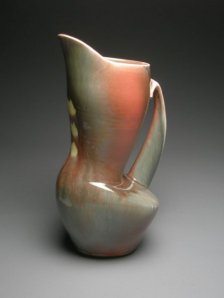 Well I do work a lot. I have become comfortable teaching workshops and instead of being nervous all the time I can think about my work and even brainstorm through demoing. So in a way I can do a little research and development while teaching. Also I have become quite interested in the way that people learn. I enjoy working with individuals of all sorts to help them accomplish their own goals with their work and their creative process. So teaching balances my studio time really well. It is a rest and work at the same time. I love to travel, especially when I do not have to take my whole studio with me! So there is not a lot of balance, just a lot of both.
Well I do work a lot. I have become comfortable teaching workshops and instead of being nervous all the time I can think about my work and even brainstorm through demoing. So in a way I can do a little research and development while teaching. Also I have become quite interested in the way that people learn. I enjoy working with individuals of all sorts to help them accomplish their own goals with their work and their creative process. So teaching balances my studio time really well. It is a rest and work at the same time. I love to travel, especially when I do not have to take my whole studio with me! So there is not a lot of balance, just a lot of both.
How do you come up with new ideas? Can you walk us through your creative process when coming up with new forms/ideas?
New forms come about in many ways. Within every days’ journey I sift through small visual that build into ideas over time. Sometimes do drawings. I sometimes see an old form differently because of the setting or the light. The process gradually changes my work due to my nature to want to be efficient and the other part of my nature that wants to complicate everything. A big practice that always keeps me going, is just to work a lot. Moving large amounts of clay keep the ideas flowing. I get ideas from using pottery at meals. I get ideas from cooking and watching others cook.
 There are two strong parts of me that seem to be most active in pushing my decisions forward. The part that wants everything to be efficient and the part the wants everything to be complicated.
There are two strong parts of me that seem to be most active in pushing my decisions forward. The part that wants everything to be efficient and the part the wants everything to be complicated.
The efficient part sees the quicker path, the leftover pieces as desirable, the perfect tool/ mold for a certain job, the augmentation that will make the course of action easier. The practical part simplifies multi-step processes and finds clarity.
The complicating part embellishes, has fun with shape, creates lines that inspire, wants to do crazy amounts of glaze testing, wants to bring every part of life into my work. The complicating part turns a simple angle in to a kaleidoscope. It plays.
 So these ways of seeing or thinking work together back and forth until and ideas exists and is refined. My mom wanted a dish to serve asparagus in. In my head that mean oval. I needed more simple forms at that time. So I designed an oval dish with in the processes that I enjoyed… Hand built/ molded foot and thrown and altered wall/rim. Over time this shape as evolved into a large more complicated shape that includes tea drop shaped form with a handle at one end and sets of the two together. I have also used the same mold to create a segmented tray in a kaleidoscoping pattern. Eventually the simple form gets complicated and I start other simple forms that eventually evolve… I enjoy the back and forth and puzzeling of shapes.
So these ways of seeing or thinking work together back and forth until and ideas exists and is refined. My mom wanted a dish to serve asparagus in. In my head that mean oval. I needed more simple forms at that time. So I designed an oval dish with in the processes that I enjoyed… Hand built/ molded foot and thrown and altered wall/rim. Over time this shape as evolved into a large more complicated shape that includes tea drop shaped form with a handle at one end and sets of the two together. I have also used the same mold to create a segmented tray in a kaleidoscoping pattern. Eventually the simple form gets complicated and I start other simple forms that eventually evolve… I enjoy the back and forth and puzzeling of shapes.
What does a typical workday look like for you?
I get up around 7-8am. I put on hot water for coffee/tea and check on the house-plants. I keep both a short and long term list that I consult toward the beginning of the day. They help me stay on track and somewhat realistic about what can be accomplished with the time I have. Once or twice a week I get to do Bikram Yoga first thing in the morning. Often I start the day off working on the unfinished projects from the day before. Then I have coffee and read (right now it is my Baker Creek Heirloom Seed Catalog ). Then check emails. The majority of the late morning and afternoon I work on studio projects and usually work till I am hungry. Lunch is small and quick. When I take intermittent breaks, I weed the garden, prune trees, read, rake leaves, practice banjo, go for walks, surf the web, get some bread rising, or some other interest. Then I work further on more projects till 2pm or so. Then have lunch. Then work till 7 or so and have dinner. Possibly work after dinner depending on deadlines.
I work almost everyday on what I think of as everything it takes to make pottery for a living. This includes managing gallery relationships/ workshops/ sales/ writing articles/ making work. I also think of my work to include packing and shipping, taking photos, managing a website, social media, making promotional materials. It is a good time!
What is your most valuable studio tool? Why?
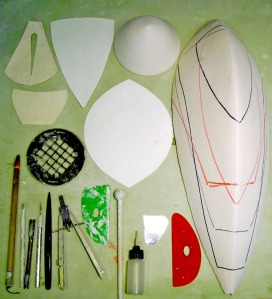 As far as a tool from the toolbox, my favorite tool it my little scoring tool. It has the same handle as a needle tool and about ten small straight metal wires that act as tines. I can gently and exactingly score small areas. This makes for less clean up and less cracking (because it is thorough scoring). It also works well for fishing out small, fallen pieces of clay from the interior of a cup, teapot, or vase form as I am working. I would have a difficult time making my work without it.
As far as a tool from the toolbox, my favorite tool it my little scoring tool. It has the same handle as a needle tool and about ten small straight metal wires that act as tines. I can gently and exactingly score small areas. This makes for less clean up and less cracking (because it is thorough scoring). It also works well for fishing out small, fallen pieces of clay from the interior of a cup, teapot, or vase form as I am working. I would have a difficult time making my work without it.
I have always admired your ability to connect to your audience using social media. What kind of advice could you give about marketing on the Internet?
Initially, I was very resistant to using social media. A good friend, Andrea Marquis and my sister, Joanna Schwartzkopf, set up my first MySpace account against my wishes for a birthday present. I eventually got used to MySpace and then found others I liked more. Michael Kline helped me set up my Twitter Account just a short while ago. I participated in  Hide’N’Seeka on instagram by Adam Field! Since then, I try to use whatever avenue I can find to put my work in front of others. I think that these social media platforms can be a huge distraction and strangely detached from the way I think. However, they are inexpensive and have the capability to reach huge numbers of people.
Hide’N’Seeka on instagram by Adam Field! Since then, I try to use whatever avenue I can find to put my work in front of others. I think that these social media platforms can be a huge distraction and strangely detached from the way I think. However, they are inexpensive and have the capability to reach huge numbers of people.
When I post information I try to have good images and to be as succinct as possible. On Google Analytics I can see the connection between posts on FB and visits to my site. I am still learning how to best use these tools, but noticing these correspondences helps direct my decisions.
As much as I think these avenues are helpful, I still love to make postcards, cards, and posters. I enjoy these longer lasting ways of promotion along with the more digital ones.
Which marketing venue(s) (website/blog/galleries/studio sales/etsy/craft fairs/etc.) have you found to be the most lucrative for your work? Are there other methods of marketing that you’re thinking about taking on?
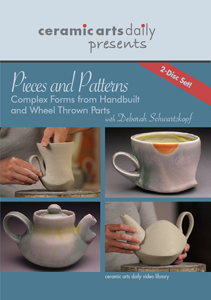 I would not say that selling pottery is ever lucrative… It feels like a tremendous amount of work for the yield.
I would not say that selling pottery is ever lucrative… It feels like a tremendous amount of work for the yield.
I sell most of my work through galleries. I am grateful for the galleries that professionally promote work through great publications, a strong web presence and by highlighting their artists yearly. Galleries have helped me get my work into many communities. Solo shows I have had through galleries give me helpful deadlines that prompt me to develop new work. Here is a link to the list I work with…
Second in line are studio sales that have been hosted by groups-
-Art of the Pot in Austin, TX (http://artofthepot.com/)
-Art School at Old Church in Demarest, NJ (http://www.tasoc.org/)
-Dallas Pottery Invitational, TX (http://dallaspotteryinvitational.com/)
 These are especially fun. Meeting other artists, getting to see others’ work, traveling, and also interacting with those who purchase the pottery are all highpoints of this way of selling for me. For the first time I am hosting a studio tour/ sale this December for the first time. This is a part of a city wide tour called Seattle Sampling. We invited five artist friends from the area to participate. We are excited to see how this all works out. I am hoping to start a sale in the spring as well.
These are especially fun. Meeting other artists, getting to see others’ work, traveling, and also interacting with those who purchase the pottery are all highpoints of this way of selling for me. For the first time I am hosting a studio tour/ sale this December for the first time. This is a part of a city wide tour called Seattle Sampling. We invited five artist friends from the area to participate. We are excited to see how this all works out. I am hoping to start a sale in the spring as well.
Occasionally I get commissions through emails or word of mouth. I really enjoy working with individuals on projects. I have so many glaze colors. This that usually allows the buyer to fine a color scheme with in my palette. I send images of past work or meet in person, we talk about how the piece will fit into their home or how it will be used. It is a good feeling to get to know the collector and see where my work is going.
Now that I have a studio/home set up of my own I have space to keep finished inventory. This has led to another option I am pursuing. Web Sales. I recently had an ecommerce site designed and I am figuring out how to manage this as well.
 One other avenue that is new is Objective Clay. This is group of potters working as a collective. We promote each other, have web sales, and we are trying to plan events and educational opportunities with in our community using the skills and information of the group. It is pretty exciting to see where this will go!
One other avenue that is new is Objective Clay. This is group of potters working as a collective. We promote each other, have web sales, and we are trying to plan events and educational opportunities with in our community using the skills and information of the group. It is pretty exciting to see where this will go!
Here is our group! Jennifer Allen, Nick Bivins, Blair Clemo, Sunshine Cobb, Bryan Hopkins, Brian Jones, Lindsay Oesterritter, Kip O’Krongly, Doug Peltzman, Monica Ripley, Deb Schwartzkopf, Shawn Spangler, Emily Schroeder Willis, gwendolyn yoppolo. Presenters at the Utilitarian Clay Symposium in 2012 at Arromont School of Arts and Crafts. (http://www.arrowmont.org/news/news/158-utilitarian-clay-vi)
At what point in your career did you make the decision to sell your pots for a living? Could you describe how you came to that decision?
 I feel like the combination of a great undergrad program at UAA and working for potters, Kris Bliss and Peter Brondz sparked my interest. I had learned skills and practiced. I saw Kris and Peter living out the life I wanted. I was particularly drawn to the studio set up Peter has. Timber framed studio surrounded by woods, lots of kilns- gas, wood, and salt kiln, chickens, great family, lovely neighbors- It all seemed to beautiful to be true. And at the same time it was right in front of me and quite attainable. I came from a very practical family but was still encouraged to dream. I set my sights on having a studio, home and life like Peter’s and just tried to make each step bring me closer to that somehow.
I feel like the combination of a great undergrad program at UAA and working for potters, Kris Bliss and Peter Brondz sparked my interest. I had learned skills and practiced. I saw Kris and Peter living out the life I wanted. I was particularly drawn to the studio set up Peter has. Timber framed studio surrounded by woods, lots of kilns- gas, wood, and salt kiln, chickens, great family, lovely neighbors- It all seemed to beautiful to be true. And at the same time it was right in front of me and quite attainable. I came from a very practical family but was still encouraged to dream. I set my sights on having a studio, home and life like Peter’s and just tried to make each step bring me closer to that somehow.
Finally, what advice can you give aspiring potters trying to make a living?
Work with as many instructors/ and mentors as you can. Spend as much time in the studio as you can moving material and ideas around. Build friendships. Decide your steps, each one is important. Take classes and have interests outside the studio that expand your world.
I enjoy Jack Troy’s writing. Especially this one!
From : Calling the Planet Home
by Jack Troy
Containment
I have picked up, moved, shaped,
and lightened myself of many tons of clay,
and those tons lifted, moved, and shaped me,
delivering me to this living-space
I wake and move about in,
space perhaps equal to that I have opened and enclosed in plate, cup, bowl, jug, jar.
I am thankful no one ever
led me to the pit I’d help to make in the earth,
or showed me all the clay at once.
I’m grateful no one ever said, “There.
That heap’s about a hundred fifty tons.
Go make yourself a life.
And oh, yes, here’s a drum of ink.
See what you can do with that.”
I wouldn’t have known where to begin.
For more information about Deborah and her work, please visit her website:

